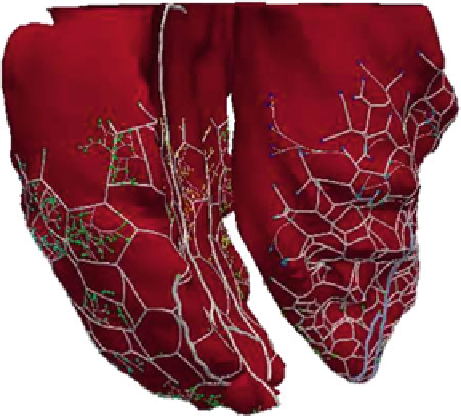Environmental Engineering Reference
In-Depth Information
Fig. 3
Purkinje network
terminations on the
ventricles endocardiac wall.
Extracted from Arís (
2014
)
The passive part is governed by a transverse isotropic exponential strain energy
function
W
(
b
)
that relates the Cauchy stress
˃
to the right Cauchy-Green deformation
b
. The passive stress is then
2
ae
b
(
I
1
−
3
)
−
e
b
f
(
I
4
−
1
)
J
σ
pas
=
(
a
)
b
+
2
a
f
(
I
4
−
1
)
f
⊗
f
+
K
(
J
−
1
)
I
.
(4)
The strain invariant
I
1
represents the non-collagenous material while strain invariant
I
4
represents the stiffness of the muscle fibers, and
a
b
f
are parameters to be
determined experimentally.
K
sets the compressibility, while vector
f
defines the
fiber direction (Fig.
3
).
,
b
,
a
f
,
2.1.3 Electromechanical Coupling
The active part of the material model drives the electromechanical action. It depends
on the ionic concentration in the tissue. The electrical component is initiated where
the Purkinje system delivers the initial impulse and simulates the transmembrane
potential propagation.
Cardiac mechanical deformation is the result of the active tension generated by the
myocytes. The model includes passive and active properties of the myocardium. It
assumes that the active stress is produced only in the direction of the fiber and depends
on the calciumconcentration of the cardiac cell, as described byNiederer et al. (
2006
):
Ca
2
+
]
n
[
˃
act
=
ʳ
C
50
˃
max
(
1
+
ʲ(ʻ
f
−
1
)).
(5)
[
Ca
2
+
]
n
+

Search WWH ::

Custom Search